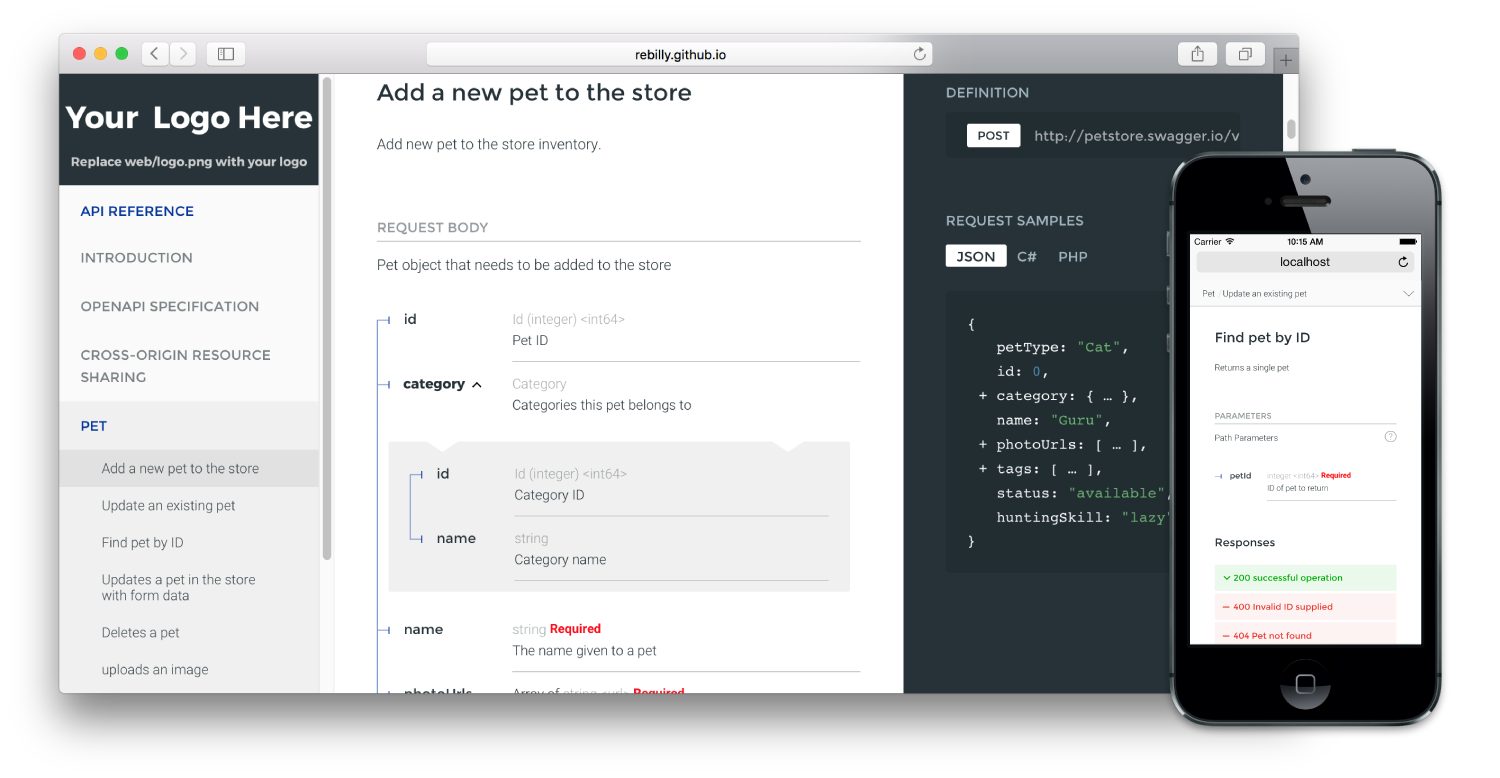OpenAPI/Swagger-generated API Reference Documentation
- Extremely easy deployment
- The widest OpenAPI v2.0 features support (yes, it supports even
discriminator)

- Neat interactive documentation for nested objects

- Code samples support (via vendor extension)

- Progressive loading with
lazy-renderingoptions

- Responsive three-panel design with menu/scrolling synchronization
- Integrate API Introduction into side menu - ReDoc takes advantage of markdown headings from OpenAPI description field. It pulls them into side menu and also supports deep linking.
- High-level grouping in side-menu via
x-tagGroupsvendor extension - Multiple ReDoc instances on single page (example)
- OpenAPI v3.0 support
-
performance optimizations -
better navigation (menu improvements + search) - ability to simple branding/styling
- built-in API Console
- docs pre-rendering (performance and SEO)
We host the latest and all the previous ReDoc releases on GitHub Pages-based CDN:
- particular release, e.g.
v1.2.0: https://rebilly.github.io/ReDoc/releases/v1.2.0/redoc.min.js v1.x.xrelease: https://rebilly.github.io/ReDoc/releases/v1.x.x/redoc.min.jslatestrelease: https://rebilly.github.io/ReDoc/releases/latest/redoc.min.js this file is updated with each release of ReDoc and may introduce breaking changes. Not recommended to use in production. Use particular release orv1.x.x.
| ReDoc Release | OpenAPI Specification |
|---|---|
| 1.19.x | 2.0 |
| 1.18.x | 2.0 |
| 1.17.x | 2.0 |
<!DOCTYPE html>
<html>
<head>
<title>ReDoc</title>
<!-- needed for adaptive design -->
<meta charset="utf-8"/>
<meta name="viewport" content="width=device-width, initial-scale=1">
<!--
ReDoc doesn't change outer page styles
-->
<style>
body {
margin: 0;
padding: 0;
}
</style>
</head>
<body>
<redoc spec-url='https://petstore.swagger.io/v2/swagger.json'></redoc>
<script src="https://rebilly.github.io/ReDoc/releases/latest/redoc.min.js"> </script>
</body>
</html>That's all folks!
IMPORTANT NOTE: if you work with untrusted user spec, use untrusted-spec option to prevent XSS security risks.
Install using bower:
bower install redoc
or using npm:
npm install redoc --save
For CDN:
<script src="https://rebilly.github.io/ReDoc/releases/latest/redoc.min.js"> </script>For bower:
<script src="bower_components/redoc/dist/redoc.min.js"> </script>For npm:
<script src="node_modules/redoc/dist/redoc.min.js"> </script><redoc spec-url="url/to/your/spec"></redoc>You can inject Security Definitions widget into any place of your specification description. Check out details here.
ReDoc makes use of the following vendor extensions:
x-logo- is used to specify API logox-traitTag- useful for handling out common things like Pagination, Rate-Limits, etcx-code-samples- specify operation code samplesx-examples- specify JSON example for requestsx-nullable- mark schema param as a nullablex-displayName- specify human-friendly names for the menu categoriesx-tagGroups- group tags by categories in the side menux-servers- ability to specify different servers for API (backported from OpenAPI 3.0)x-ignoredHeaderParameters- ability to specify header parameter names to ignore
spec-url- relative or absolute url to your spec file;untrusted-spec- if set, the spec is considered untrusted and all HTML/markdown is sanitized to prevent XSS. Disabled by default for performance reasons. Enable this option if you work with untrusted user data!scroll-y-offset- If set, specifies a vertical scroll-offset. This is often useful when there are fixed positioned elements at the top of the page, such as navbars, headers etc;scroll-y-offsetcan be specified in various ways:- number: A fixed number of pixels to be used as offset;
- selector: selector of the element to be used for specifying the offset. The distance from the top of the page to the element's bottom will be used as offset;
- function: A getter function. Must return a number representing the offset (in pixels);
suppress-warnings- if set, warnings are not rendered at the top of documentation (they still are logged to the console).lazy-rendering- if set, enables lazy rendering mode in ReDoc. This mode is useful for APIs with big number of operations (e.g. > 50). In this mode ReDoc shows initial screen ASAP and then renders the rest operations asynchronously while showing progress bar on the top. Check out the demo for the example.hide-hostname- if set, the protocol and hostname is not shown in the operation definition.expand-responses- specify which responses to expand by default by response codes. Values should be passed as comma-separated list without spaces e.g.expand-responses="200,201". Special value"all"expands all responses by default. Be careful: this option can slow-down documentation rendering time.required-props-first- show required properties first ordered in the same order as inrequiredarray.no-auto-auth- do not inject Authentication section automaticallypath-in-middle-panel- show path link and HTTP verb in the middle panel instead of the right onehide-loading- do not show loading animation. Useful for small docsnative-scrollbars- use native scrollbar for sidemenu instead of perfect-scroll (scrolling performance optimization for big specs)
Instead of adding spec-url attribute to the <redoc> element you can initialize ReDoc via globally exposed Redoc object:
Redoc.init(specOrSpecUrl, options)specOrSpecUrl is either JSON object with specification or an URL to the spec in JSON or YAML format.
options is javascript object with camel-cased version of <redoc> tag attribute names as the keys, e.g.:
Redoc.init('https://petstore.swagger.io/v2/swagger.json', {
scrollYOffset: 50
})- Clone repository
git clone https://github.com/Rebilly/ReDoc.git - Go to the project folder
cd ReDoc - Install dependencies
npm install - (optional) Replace
demo/swagger.yamlwith your own schema - Start the server
npm start - Open
https://localhost:9000
Alternatively, Docker can be used by just running docker-compose up.





